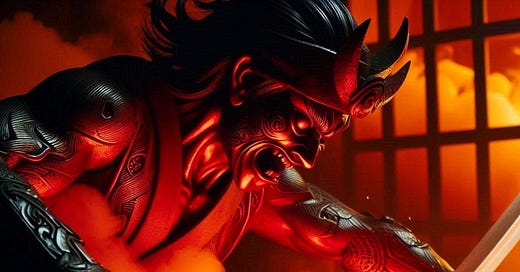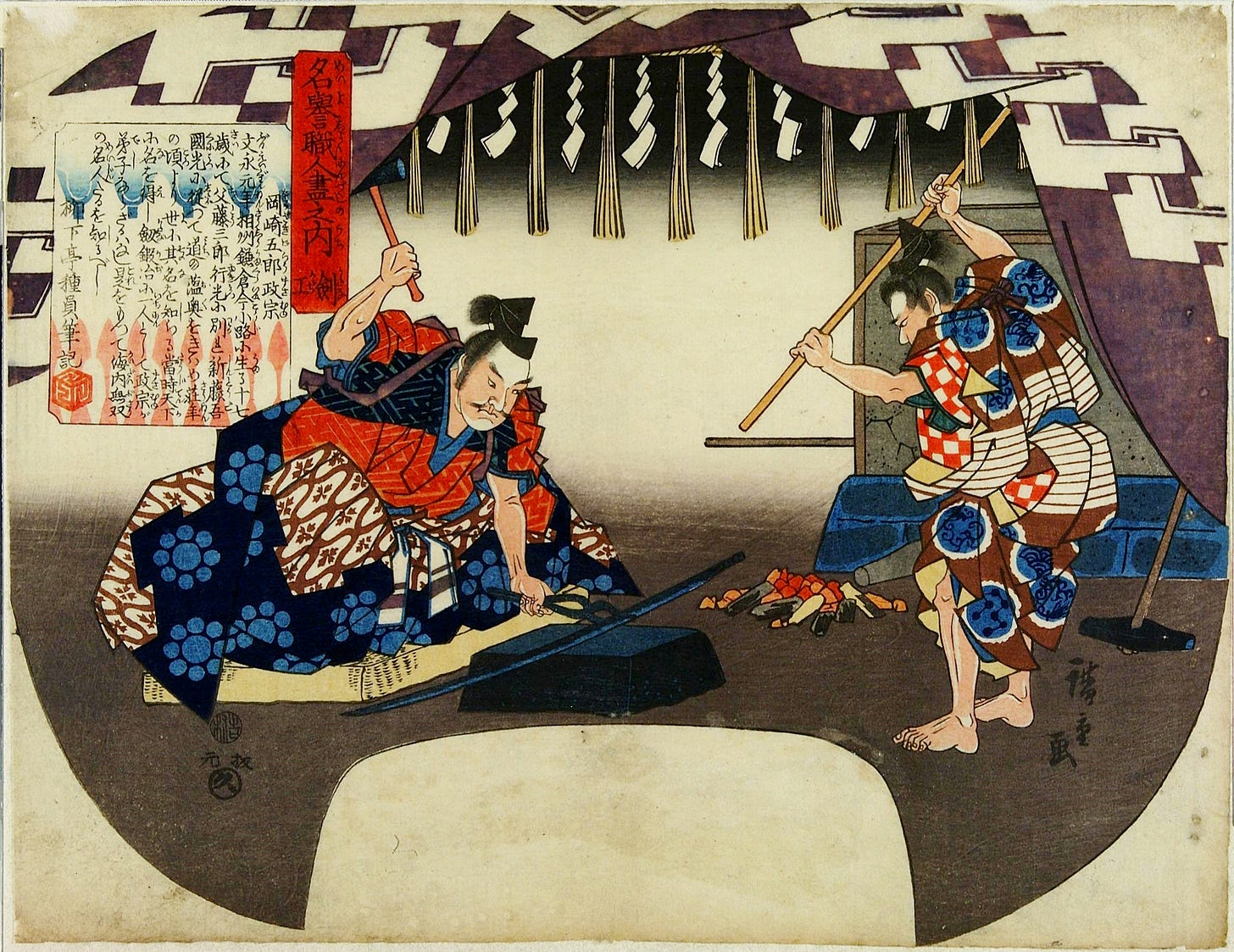The Evil and the Good.
The search for perfection and the Japanese swordsmiths that became a moral metaphor.
Masamune and Muramasa, artistic perfection, but polar opposites in terms of humanity.
Close encounter.
The only Masamune blade I ever saw was in the Victoria and Albert Museum in London. It took pride of place in the Toshiba Gallery and, to my eyes, glowed with an ethereal aura in its perfection and its nakedness.
The blade was presented in its own display case, lit from above, it almost sparkled in its craftsmanship and supreme excellence.
Here was the metallurgist’s skill at the total apex of what is humanly possible. It was flawless, and looked as if it were made yesterday, yet it was actually forged around 740 years ago.
Surviving European blades of the same age (from the 1200’s) are generally just crude lumps of rusted metal; little more than butcher’s cleavers.
The blade was ‘attributed’ to the great master Masamune, there is a kind of signature in gold (very few of his blades were actually signed, or if they were, the signature was removed as they were shortened from Tachi to Katana). It was presented unadorned, with a plain wooden hilt and scabbard, no hand guard, I suspect it was mounted that way, so that it was protected in storage.
The museum website tells us that the blade is sadly no longer on display. Here are the details, showing the actual blade:
https://collections.vam.ac.uk/item/O92843/sword-and-scabbard-masamune/
The history.
Masamune Gorō (1264 -1343) Kamakura period master swordsmith and sometime priest, was much sought after in his own lifetime. His metallurgical knowledge and application were truly way ahead of his time. His blades were greatly prized by the most powerful players in Japanese history, and passed forward through the generations; this is partly why so many of them have survived.1
Many of his swords were forged tachi-style (slung in a blade-down manner) but, as trends changed they were cut down to the shorter katana-style. No examples of Masamune tachi-style blades exist, but plenty of katana, wakizashi and tanto.
An image of Masamune at work in his forge.
Rivalry for reputation.
Enter the arch-villain of Japanese swordsmiths; Muramasa ‘Sengo’ (dates only estimated, born, before 1341?) Note, there is very little chance that Muramasa could have met Masamune, but…
According to legend, Muramasa was a man in possession of an unstable mind and a violent temper, to the level of insanity; truly evil, if you believe the folklore.
Crucially, Muramasa’s evil spirit is supposed to be infused into his blades, which developed a reputation for being literally ‘bloodthirsty’. They brought ill-fortune on all who possessed them, sometimes leading to madness and suicide. It is said that the swords could not be returned to the scabbard unless they had tasted blood, even if it was the blood of their owners; they needed to be literally ‘fed’ on a regular diet of human blood.
Indeed, some of the more famous owners of these swords ended up on the wrong side of fortune and some did come messily unstuck, but there is also a suggestion that some of this reputation may have a political element, to justify the ill-fortunes of historical characters.
Sword testing – good versus evil.
How the Muramasa blades tended to be compared to the Masamune blades is a kind of ‘acid/alkali’ thing. Both swordsmiths produced weapons of almost unimaginable quality, but it was the moral infusion that was the real test.
To understand this, you have to get to grips with the sacred nature of the sword in Japanese culture; which goes way back into prehistory. There’s no real western equivalent of this; the nearest I can think of is King Arthur’s sword Excalibur; but the nature of Excalibur is not reflected in the sanctity of its manufacture, but instead in its magical powers.
The Japanese sword’s sacredness has not diminished over time; in fact, it seems to have increased. If we just consider for a moment the ‘life-giving sword’ and the ‘life-taking sword’’ (katsujinken and satsujinken); these two concepts seem to be tied to the higher realms of morality, and moved away from the sword as purely an instrument of death. The Japanese sword is no mere tool of violence in the name of power; though its potency is (in part) derived from the fact that it has the capacity to reap havoc.
How the blades were matched against each other…allegedly.
The story goes that there was supposed to be a test of quality arranged between a Muramasa blade and a Masamune blade.
The two swords were held point-downwards in a fast-moving stream, with their cutting edges facing upstream. It is said that with the evil Muramasa blade anything travelling downstream; leaves, fishes etc. were drawn towards the cutting edge as if by magic and were thus, indiscriminately, sliced in half, apparently even the air was sliced by the powerful compulsion contained in the blade.
With Masamune’s blade the fish were not worried by it and leaves just slipped by (another version said that the sliced leaves magically rejoined after being cut).
Stories like this are apocryphal but loaded with meaning and symbolism.
From any ancient culture with developed metallurgical arts, you will see a pattern where the sword (or spear) as a man-made utilitarian item is somehow imbued with an almost religious power. This separates it from a mere tool or implement, like a spade, a hoe, or even another cutting tool like a chisel.
To round things off.
My memories of seeing the Masamune blade on display in the museum revolve around the fact that the blade drew me towards it as an object of profound beauty, not as a gruesome artifact of death and butchery. Or maybe I am selectively editing my own memory. But, its presence has stayed with, otherwise I wouldn’t be writing about it now.
I do wish the V&A would put it back on display.
In 1945 as the Americans occupied and demilitarised Japan there was a great ‘sword hand-in’ and a famous Masamune blade, the Honjō Masamune, was delivered to the Meijiro Police station. According to Wikipedia, “In January 1946, the Mejiro police gave the swords to a man identified as "Sgt. Coldy Bimore" (possibly a garbled phonetic spelling of the man's name) of the Foreign Liquidations Commission of AFWESPAC (Army Forces, Western Pacific). In an episode of ‘Expedition Unknown’, Josh Gates travelled to Japan in search of the Honjō Masamune and learned that there were no records of a "Sgt. Coldy Bimore" listed to have received the sword. The Honjō Masamune is the most important of the missing Japanese swords, and its current location remains unknown. Only vague theories exist as to the location of the sword.”





